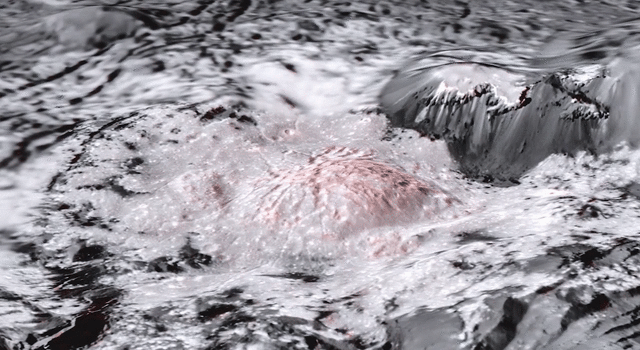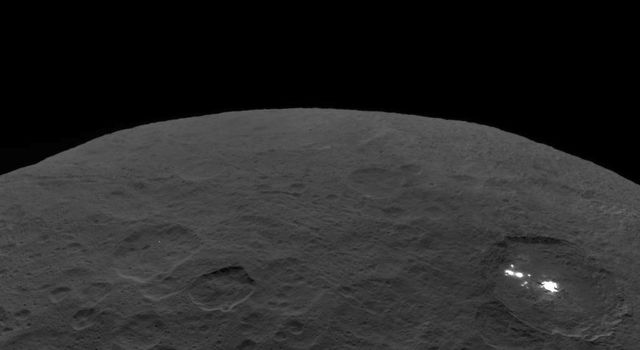Blogs | Dawn Journal | October 31, 2011
Dear Dawnderfuls
Dawn has completed another wonderfully successful phase of its exploration of Vesta, studying it in unprecedented detail during the past month. From the time of its discovery more than two centuries ago until just a few months ago, this protoplanet appeared as hardly more than a fuzzy blob, an indistinct fleck in the sky. Now Dawn has mapped it with exquisite clarity, revealing a fascinatingly complex alien world.
The high altitude mapping orbit (HAMO) includes the most intensive and thorough imaging of the entire year Dawn will reside at Vesta. Spectacular as the results from survey orbit were, the observations from HAMO are significantly better. From four times closer to the surface, Dawn’s sensors provided much better views of the extraordinary surface of craters large and small, tremendous mountains, valleys, towering cliffs, ridges, smooth and flat regions, gently rolling plains, systems of extensive troughs, many clusters of smaller grooves, immense landslides, enormous boulders, materials that are unusually bright and others that are unusually dark (sometimes adjacent to each other), and myriad other dramatic and intriguing features. There is no reason to try to capture in words what visual creatures like humans can best appreciate in pictures. To see the sites, which literally are out of this world, either go to Vesta or go here.
Circling the colossus 680 kilometers (420 miles) beneath it in HAMO, the probe has spent most of its time over the illuminated side taking pictures and other scientific measurements and most of the time over the dark side beaming its precious findings back to eager Earthlings.
Dawn revolves in a polar orbit around Vesta, passing above the north pole, then traveling over the day side to the south pole, and then soaring north over the night side. Each circuit takes 12.3 hours. Meanwhile, Vesta completes a rotation on its axis every 5.3 hours. Mission planners choreographed this beautiful cosmic pas de deux by choosing the orbital parameters so that in 10 orbits, nearly every part of the lit surface would come within the camera’s field of view. (Because it is northern hemisphere winter on that world, a region around the north pole is hidden in the deep dark of night. Its appearance in Dawn’s pictures will have to wait for HAMO2.) A set of 10 orbits is known to Dawn team members (and now to you) as a mapping cycle.
Although the HAMO phase was extremely complex, it was executed almost flawlessly, following remarkably well the intricate plan worked out in great detail last year. It consisted of six mapping cycles, and they were conducted in order of their overall importance. In the first cycle, Dawn aimed its camera straight down and took pictures with all of the instrument’s color filters. In addition to showing the startling diversity of exotic features, the color images provide scientists some information about the composition of the surface materials, which display an impressive variation on this mysterious protoplanet. Cycle 1 yielded more than 2500 photos of Vesta, nearly as many as were acquired in the entire survey orbit phase. These observations were deemed so important that not only were they first, but cycle 6 was designed to acquire nearly the same data. This strategy was formulated so that if problems precluded the successful mapping in cycle 1, there would be a second chance without requiring the small and busy operations team to make new plans. As it turned out, there were only minor glitches that interfered with some of the pictures in cycle 1, but the losses were not important. Nevertheless, cycle 6 did fill in most of the missing views.
Cycles 2 through 5 were devoted to acquiring images needed to develop a topographical map. Instead of flying over the sunlit side with its camera pointed straight down, the spacecraft looked at an angle. Each direction was chosen to provide scientists the best combination of perspective and illumination to build up a three dimensional picture of the surface. Knowing the elevations of different features and the angles of slopes is essential to understanding the geological processes that shaped them.
In cycle 2, the camera constantly was directed at the terrain ahead and a little to the left of the point directly below the spacecraft. Cycle 3, in contrast, looked back and slightly to the left. Cycle 4 pointed straight ahead but by a smaller angle than in cycle 2. Cycle 5 did not look forward or backwards; it only observed the surface to the right. With the extensive stereo coverage in each of these 10-orbit mapping cycles, most of the terrain now has been photographed from enough different directions that the detailed shape of the alien landscape can be determined.
The HAMO observations constitute the most comprehensive visible mapping of Vesta for the mission. The survey orbit images were obtained from a higher altitude and so do not show as much detail. When Dawn flies down to its low altitude mapping orbit (LAMO), its primary objectives will be to measure the atomic constituents with the gamma ray and neutron detector (GRaND) and to map the gravitational field. While some images will be acquired, they will be a secondary objective. The principal resources, both for the spacecraft and for the operations team, will be devoted to the higher priority science. In addition, the probe will be too close in LAMO for its camera to collect enough pictures for a global map. The subsequent observations in HAMO2 will be designed mostly to glimpse some of the northern latitudes that are currently too dark to see.
The more than 7000 images Dawn acquired in HAMO will form a very firm basis for years of productive study. Combined with the other data the explorer returns from Vesta, we will follow the global maps to find exciting new insights about the solar system. What better destination could the maps guide us to?
Included in the “other data” is a collection of fabulous new observations with the visible and infrared mapping spectrometer (VIR). A spectrum is the intensity of light at different wavelengths. When you enjoy the sight of light dispersed through a prism, which decomposes white light into its constituent colors, you have a similar view. The material on Vesta leaves its signature in the spectrum of light it reflects from the sun. Each VIR snapshot produces a “frame,” which consists of a full spectrum, from a portion of ultraviolet through the entire visible range into infrared, at 256 distinct locations on the surface. Every frame contains a richness of information.
The direction in which Dawn pointed its instruments in HAMO was dictated by the plan for thoroughly mapping Vesta with the camera. Nevertheless, VIR was used to acquire a sumptuous set of spectra which are the principal means by which scientists will determine the nature of the minerals on its surface. The spectra extend far enough into the infrared that they also measure the meager heat radiated from the surface, thereby acting as a thermometer.
As with the pictures from the camera, the VIR frames in HAMO benefit from the lower altitude by showing more detail than those acquired in survey orbit. VIR acquired 15 thousand frames in HAMO, yielding full spectra on nearly four million regions over Vesta’s vast surface.
The spectra from VIR provide greater chromatic detail than the seven color filters in the camera. The camera is able to cover larger areas with finer resolution in a single image. The two instruments are complementary, and together they contribute to developing a detailed picture of the geology of Vesta.
Although the main gravity and GRaND measurements will be made in LAMO, they have already begun. The gravity investigation is revealing hints of the interior structure even before the probe travels to its lowest altitude. The nuclear radiation GRaND will measure is so weak that Dawn will need to go closer to allow that instrument to do its primary work. Nevertheless, even in HAMO it has been detecting neutrons emitted by Vesta.
After GRaND was reactivated at the end of September as part of the recovery from safe mode, scientists observed that one of its sophisticated gamma ray detectors showed an increase in noise. Scientists and engineers worked together in analyzing the telemetry from the instrument and establishing the best way to remedy it. They proceeded carefully and gradually over the course of about 10 days, first powering selected internal components off, then deactivating the entire instrument, rebooting it, and reconfiguring it. They were rewarded by seeing GRaND back to its normal performance, once again ready to contribute fully to this grand mission of exploration.
Dawn collected slightly more data during most of its transits over the lit side of Vesta than it could transmit over the subsequent dark side passes. Therefore, by the end of HAMO, it still had precious information that had accumulated in its memory. Following the completion of mapping cycle 6 early this morning, the spacecraft is spending another two days beaming the last of its findings back to the distant planet it left more than four years ago.
Engineers are taking advantage of this time with the main antenna pointed to Earth to perform some reconfigurations of the spacecraft. They are preparing it for operating closer to Vesta, where more reflected light from the surface will reach some of the sensors that keep track of the location of the sun and the vast rocky body will cause fewer stars to be visible to the star trackers. Other changes are scheduled to occur at lower altitudes.
With a truly amazingly productive HAMO phase complete and the spacecraft ready to venture on, plans are all in place for what may be the most arduous phase of the mission. On November 2 at 5:20 a.m. PDT, the ship will set sail again with its ion propulsion system to push down to its lowest orbit. It will take more than five weeks to reach LAMO. In the next log we will check in on the probe’s progress and consider some of the obstacles to be overcome in dipping so low.
In the meantime, your correspondent was inspired by the splendid results from HAMO to devise his best Halloween costume in a long time. This year, he pretended to be someone who is unmoved by the stunning views of Vesta and the extraordinary accomplishments of the indefatigable spacecraft that acquired them. He appeared not to feel the deep gratification of being a member of a species that works together to extend beyond our limitations to undertake bold adventures in search of some of the greatest rewards of all: new knowledge and new perspectives on the cosmos. He disguised himself as one who does not feel the powerful longing to share in the unveiling of an alien world. He acted as if he has not hungered for the wonderful feast Dawn is now serving. He was not only unrecognizable, but in this costume he surely would not be mistaken for any of the dawnderful readers of these logs.
Dawn is 680 kilometers (420 miles) from Vesta. It is also 2.03 AU (303 million kilometers or 184 million miles) from Earth, or 795 times as far as the moon and 2.04 times as far as the sun today. Radio signals, traveling at the universal limit of the speed of light, take 34 minutes to make the round trip.
Dr. Marc D. Rayman
11:00 p.m. PDT October 31, 2011
TAGS:DAWN







